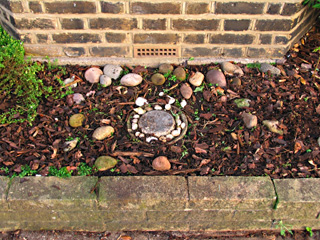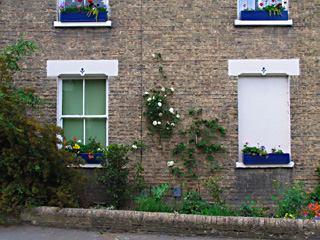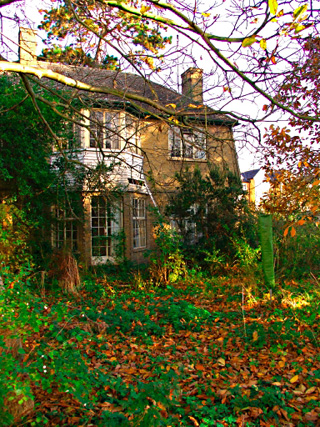Human Flower Project
The Outer Limits
With “hopes but no plan,” John Levett wanders London’s outskirts, finding attempts, recoveries, and many posthumous hedges.

Trimmer’s delight, Hayes
Photo: John Levett
By John Levett
I’m currently reading the first volume of Roy Foster’s history of modern Ireland from 1600—modern enough. I’ve fortunately arrived at the point in my life where I can now read histories purely for the pleasure of fine writing & scholarship rather than as source material for a course that I might be giving in some future year. Foster is a writer who overpowers but gently so. The breadth of his reading and intimacy with the subtleties of his characters and their places in the scheme insinuates so easily that the joy of the reading of it suddenly awakens within; there comes a small offering of thanks that sometime around 1944 my mother decided we all need history and I was going to get some. For ever.
In the olden days historians looked liked a piece of history; looked as if they’d lived it, created it, were there at its birth and had the crevices, canyons and rivulets in their faces to show their experience. I’m guessing that Foster has the landscape to show for his labours.
 Palmers Green
Palmers Green
Photo: John Levett
We lose history at the expense of losing who we are and why we’re in whatever soup we happen at any time to be in. Engagement with the past gives us a grounding for proceeding with our present. It binds us; sometimes headlong to disaster; sometimes in collective transcendence which, however briefly, gives common cause. The thing I remember most about the Obama inauguration was not the event itself but the singalong the night before: Springsteen, Seeger, et al singing Woody Guthrie’s “This Land is Your Land”. It seemed at that moment that contact with a history meant something fine, uplifting, worth keeping in touch with however shameful its proceedings sometimes are.
Recently I was giving a presentation to a group of students at King’s College London. Usually I am presenting to classes in adult education and one can reasonably make assumptions about their experience of the history they have lived through and the history that was part of their own education. Not so for my group at KCL. After ten minutes it crept up on me that this group had no background of the history I was referring to, namely, Britain in 1950. This is not a big ask is it? If I’d been banging on about a lost Plantagenet, the Treaty of Worms, the War of the Spanish Succession then I’d have made allowances. But 1950?
I have enough experience in teaching to have halted, tempered and modified and we came to a fine ending. But I was still left wondering what counts for an historical education in these islands these days. There’s no shortage of Nazis for sure. There’s been a recent tv series on the History of Scotland leaving out everyone except kings, queens, nobles or clan chieftains. Darwin is ubiquitous (and ‘Yes’ Darwin does count as history). The visuals are always stunning, seemingly always refer to climate change at some point, employ a permanently available helicopter pilot, are fronted by an impossibly young well-scrubbed up fun person without a wrinkle in sight or grubby fingers who can walk and talk at the same time. How many years spent in the archive mines for this crew? I come away with a sense that we’re now a ‘gobbet’ society not far short of history taught by Twitter.

Arnos Grove
Photo: John Levett
A few years ago I watched a series (or was it read a book, or the book of the series?) on travel which posited the idea that looking up while walking though your bog-standard street in Anytown was as good as foreign travel and you’d be amazed at the sense of wonder at the newness of your own back alley and your neighbour’s roof. You’ll want more of when it was built, why does it have that knobbly whatsit perched way out, why is that brick a different colour to the bricks there, why is that person standing naked at an open window?
Truth is, it works. These days whenever I travel up to London it’s usually because of an evening show opening or an evening meeting that I’m hosting, which gives me a good part of the day to wander. About two years ago I decided to spend these loose hours travelling to a new stop each time somewhere on the London Underground system. Looking at the map I was struck by how familiar each stop seemed. Dagenham Heathway, Roding Valley, Boston Manor, Colliers Wood, Blackhorse Road, Snaresbrook—all as common to me as next door’s vegetable patch and all never visited. I visit with hopes but no plan; no expectations but everything’s new; all of it rewards. I shouldn’t be surprised. It occurred to me early on that whenever I’m abroad (the rest of Europe’s still abroad whatever it means to be rail-connected) it’s always to the outer reaches of a city that I tend towards.
So what excites on arrival? The aspiration of the whole thing. Let me offer an analogy. A couple of days ago I was stuck on top of a bus at the end of the rush hour just outside Knightsbridge station and I spent five minutes watching a young flower seller wrapping tulips and her being caught up in the whole excitement of what she was doing; the exuberance of the dance around the vases, the constantly open face, the care of keeping her pavement space spick and span. You can’t help making up stories on these occasions—she was Asian so she’s maybe an immigrant, maybe first job, maybe making an impression, maybe making enough for treats tonight, maybe life opening up in the city—that sort of thing.
So it was in the outer limits. Where you see crumble, was once fresh brick & rendering; where now rotting railings, once painted pickets; where now subdivision, once a home of one’s own with garden patch to match. And with the house and garden the protection: the gate single or double; the wall plain or plastered; the long march to the front door or the net curtain; the inevitable hedge.

The inevitable hedge, and then some: Petts Wood
Photo: John Levett
Often it’s the hedge that fascinates. I can see the rationale of the decision to raise the beast but the pain of continuing its life passes over me. Hedge-trimming has always struck me as the dumbest thing to do in a garden. Some of these things grow faster than an adolescent’s spots. Imagine yourself snuckering down into your garden chair, cushions in place, drink at convenient height, fine novel open, sun on tap. Not a sound but the occasional flutter, rustle, squeak of strain. It’s the hedge growing. Triffid comes to mind. A persistent itch that you’ve got to scratch. However comfortable you are now you know it has to be trimmed—this month, next month, next year. Your death will come before the hedge shuffles off but that doesn’t stop the upkeep that it demands.
Grass cutting comes close. Week in, week out throughout the seasons when all you want to do is take benefit from the thing that you’ve protected from the end of autumn leaf fall through the barren months and just sit & potter in it. Wise up. No hedge. No grass. If grass it must be, then make it monumental enough that you can drive round the thing; not a postage stamp on life-support.
 Kentish Town
Kentish Town
Photo: John Levett
What attracts is The Attempt. The outpost of a once-good idea perhaps an early hope of something out of the small plot that has some invention, some difference, some picture in the head that fits into The New Beginning (somewhere once in New Addington, New Southgate, New Beckenham, New Eltham).
Against reasonable odds something reasonable often works out and the garden that often does is that which fits, that which gets pottered with, that which gets just the attention it needs to keep it trundling along. Too often gardens, of any size, get too much fussing with or maybe not too much fussing but fussing beyond needs. I think I’d put myself into the set of Recovered Fussers. This or that needs to be moved; that spot needs a thing; that thing could do with a thing in front of it; that thing needs shade; that other thing’s got too much of everything and still does nothing. Much like a family.
 Woodford
Woodford
Photo: John Levett
Whilst reading Foster in various parts of my patch (I move with the sun) I have more than a vague feeling that what I’ve got is probably what I had in mind when I began. Things have begun to self-seed; natural selection has weeded-out stuff that wasn’t ever likely to flourish as it should; I’ve been more ruthless with winter rose pruning finally realizing that I’m a good rose grower and ought to act as one. I’d still like an avenue of early spring irises like I remember at Giverny and a bed of delphiniums that I created some thirty years ago. I’d like more pots of precious pickings around the back door and a manageable herb garden. I haven’t got any geraniums and only books of campanulas. I’ll keep adding bits I’m sure but only to the point of still being able to manage just by walking around.
Around the last time I had my old delphinium bed (six medals on the trot at Hitchin Show) I had a picture in my head of running a small-holding somewhere in the Fens along a drove that hardly anyone passed over and settle for a life lived in seasonal routine with enough time for study, cycling, correspondence chess and soup with sourdough bread around fires with comrades from the East Anglian Libertarian Flat Earth Party (Winstanley Tendency). Close to the earth without obsession, futile maintenance, mowers, hedge trimmers, bankers.

